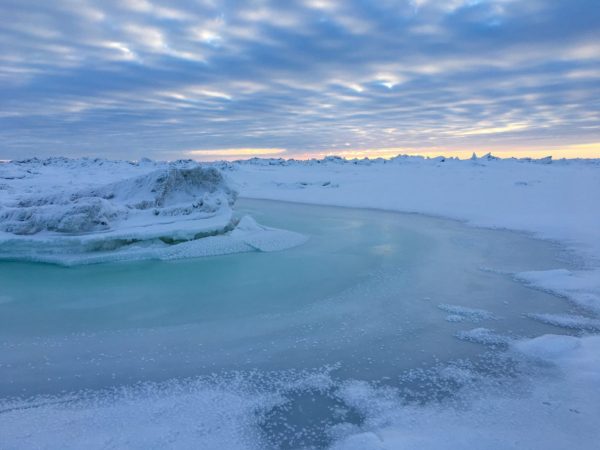
Winter storms and blustery weather buffeting the Bering Sea this month have reduced sea ice coverage by almost 25% since late January. That’s according to climate specialist Rick Thoman.
Thoman works for the Alaska Center for Climate Assessment and Policy (ACCAP) at the University of Alaska–Fairbanks. He says in the last two weeks, more areas of open water have popped up all around Western Alaska.
“As of February 10th, we are seeing significant areas of open water throughout the Southern Norton Sound, as well as areas on the north side of St. Lawrence Island and even on the south coast of Chukotka, west of Provideniya,” Thoman said. Sea ice is typically solid and stable this time of year, but Thoman says even in areas where there is ice, much of it is shifting.
The National Weather Service has issued winter storm warnings for multiple zones within Western Alaska over the last few days, including St. Lawrence Island, the Norton Sound coast near Nome, and Unalakleet. Thoman says sea ice could re-form along the Southern Seward Peninsula Coast faster than in some of the other affected areas.
“If we get through this storm that is in progress currently with decent ice conditions, then we are probably okay,” Thoman said, referring to coast near Nome. “But it looks like a different situation in Eastern Norton Sound, where there is much less ice, and that’s going to take quite a while to form. Might not be much happening as far as crabbing in those areas, same with hunting out on the ice for the Bering Strait communities.”
Thoman adds that in Shishmaref, variable ice conditions could make subsistence hunting on the ice very challenging for the rest of February.
Gay Sheffield works for the marine mammal advisory program, engaging with many whaling communities and hunters in the Bering Strait region. In terms of how subsistence hunting could be impacted by the current sea ice conditions, Sheffield says:
“It’s safe to say our resourceful harvesting communities will take advantage of any conditions… open water isn’t necessarily a bad thing,” Sheffield said.
Looking further north, Thoman says subsistence hunters will have to work around open water, a lack of thick sea ice, and moving ice ridging together.
“Even southern Kotzebue Sound is seeing some open water, as well, and that is really surprising,” Thoman said. “That water is much shallower, and that ice ought to be thoroughly stable here by the time we get to the middle of February — but not this year.”
For residents of Nome and other Bering Strait communities, Thoman recommends waiting for the storm to pass before going back on the sea ice.
“Certainly, if it’s possible, (you) might not want to be out on the ice over the next couple of days until this storm blows through and we see things start to settle down,” Thoman said. “We will have a couple of days of colder, not-so-stormy weather coming up, so while we might not see much in the way of sea ice growth, (we) should see things stabilize at least a little bit.”
As sea ice extent changes dramatically in the Bering Sea, Thoman says it is always helpful to be vigilant and to report your observations. Alaskans who want to share what they see with professional weather observers can contact the local environmental network (LEO).
